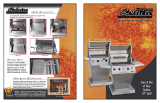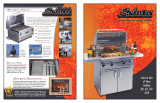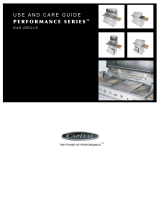
2
SAFETY AND WARNINGS
z
Do not store a full LP tank in direct sunlight.
z
After a period of storage or non-use, the appliance should be checked for gas leaks,
deterioration, proper assembly, and burner obstructions before use.
General Use
z
This appliance is not intended to be installed in or on recreational vehicles, trailers or
boats.
z
After lighting burners, ensure they are operating correctly.
z
When using the appliance, be sure that all parts of the unit are firmly in place and that
everything is stable.
z
On cart mounted units, never move without first allowing the appliance to cool,
disconnecting the cable and ensuring that the gas supply is turned off.
z
Do not move the appliance during use.
z
Children should not be left alone or unattended in an area where the product is being
used. Never allow them to sit, stand or play on or around the unit at any time.
z
Do not store items of interest to children around or below the appliance.
z
Never use the appliance in a windy area.
z
To put out flare-ups, adjust the controls to lower the temperature.
z
Do not obstruct the flow of combustion and ventilation to the appliance.
z
Spiders and insects can nest in the burners or openings and can block or restrict the
burner. This can cause a flash back to the control panel which can cause a fire.
z
Do not try lighting this appliance without reading the lighting instruction in the user guide.
z
Do not locate, store or operate the appliance on a slope.
z
This product must be installed by a licensed plumber or gas fitter when installed within
the Commonwealth of Massachusetts.
z
Do not fill the gas tank more than 80% of its total capacity.
z
Never use a dented or rusty LP tank. Keep the ventilation openings of the cylinder
enclosure free and clear from debris.
z
Clean and perform general maintenance on the appliance regularly. Watch for corrosion,
cracks, or insect activity. Check the regulator, hoses, burner ports, air shutter, and venturi/
valve section carefully. Always turn off gas at the source prior to inspecting.
z
You must inspect the unit at least once a year or immediately if the smell of gas is present
in conjunction with the burner flames appearing yellow, the appliance does not reach
temperature or heats unevenly or the unit makes popping noises.
z
Do not smoke while leak testing and extinguish all open flames.
z
When cleaning the burners centre the burner onto the orifice correctly and ensure they
are level before lighting to prevent fire hazard or explosion. Refer to the user guide for
detailed guidance.
z
Use only a Ground Fault Interrupter (GFI) protected circuit with this outdoor cooking gas
appliance.
z
Unplug from the outlet when not in use and before cleaning. Allow to cool before putting
on or taking off parts.
z
Do not operate the appliance with a damaged cord, plug, or after the appliance
malfunctions or has been damaged in any manner. Contact the manufacturer for repair.
z
Do not let the cord hang over the edge of a table or touch hot surfaces.
z
When connecting, first connect plug to the appliance then plug appliance into the outlet.
z
Do not place the unit directly on the ground or other surface without support. This will
prevent damage to the regulator/hose assembly.
Gas requirements
z
This appliance can be used with any brand of 20lb LP gas tank provided it is
compatible with a proper retention device (not supplied).
z
The LP gas cylinder must be:
z
Designed for use with a Type 1 system only.
z
Constructed and marked in accordance with the Specifications for LP gas Cylinders
of the U.S. Department of Transportation (D.O.T.) or the Standard for Cylinders,
Spheres and Tubes for Transportation of Dangerous Goods and Commission, CAN/
CSA-B339
z
Provided with a listed overfilling prevention device.
z
Provided with a cylinder connection device compatible with the connection for
outdoor cooking gas appliances
z
The cylinder must be provided with a shut-off valve terminating in an LP gas supply
cylinder valve outlet specified, as applicable, for connection Type 1.
z
Do not change the regulator/hose assembly from that supplied with the unit or attempt
to use a Type 1 equipped regulator/hose assembly with a standard 510 POL tank/valve
assembly.
z
Never use a cylinder with a damaged valve. The cylinder that is used must have a collar
to protect the cylinder valve.
z
An installer-supplied gas shut-off valve must be installed in an easily accessible location
z
All installer supplied parts must conform to local codes, or in the absence of local
codes, with the National Electrical Code, ANSI/NFPA 70 or the Canadian Electrical
Code, CSA C22.1, and the National Fuel Gas Code, ANSI Z223.1 or CSA-B149.1 Natural
Gas Installation Code or CSA-B149.2 Propane Installation Code.
z
In Massachusetts such shut-off valves should be approved by the Board of State
Examiners or Plumbers & Gas Fitters.
z
All pipe sealants must be an ap proved type and resistant to the actions of LP gases.
Never use pipe sealant on flare fittings.
z
A dented or rusty LP tank may be hazardous and should be checked by your LP
supplier.
z
Always check for leaks after every LP tank change.
z
For LP units, check for leaks with a full cylinder.
z
Do not use the appliance until all connections have been checked and do not leak.
z
Before each use, inspect the gas supply piping or hose prior to turning the gas
ON. If there is evidence of cuts, wear, or abrasion, it must be replaced prior to use.
The pressure regulator and hose assembly supplied with the unit must be used. If
replacements are needed, contact customer care at www.dcsappliances.com
SAVE THESE INSTRUCTIONS
The models shown in this installation guide may not be available in all markets and are subject to
change at any time. For current details about model and specification availability in your country,
please visit our website dcsappliances.com or contact your local DCS dealer.






















